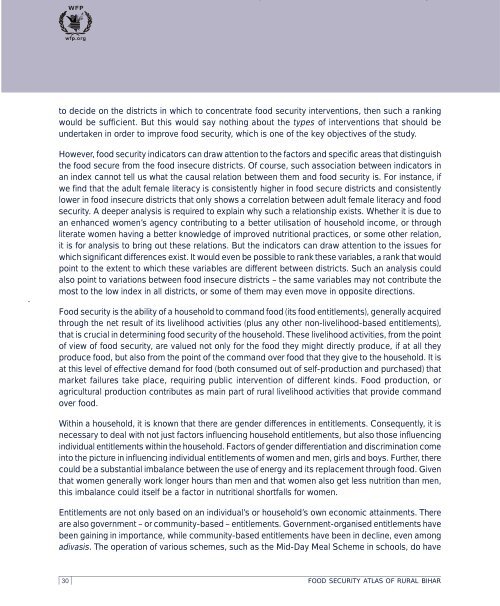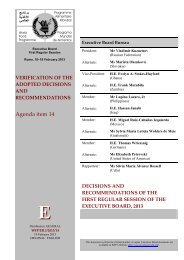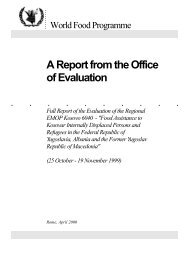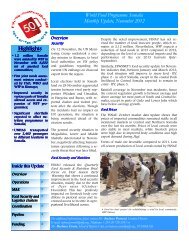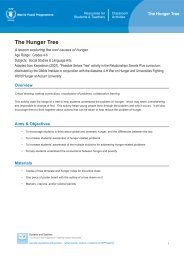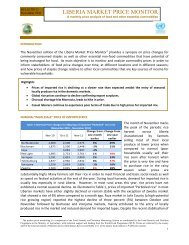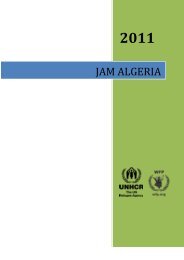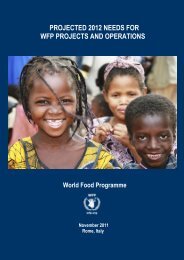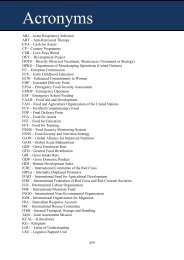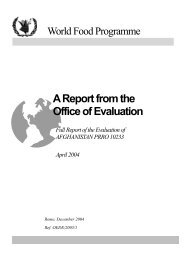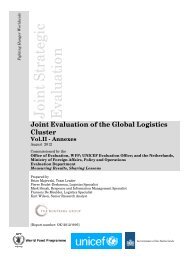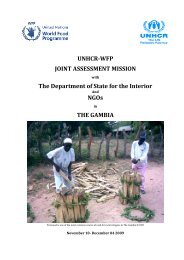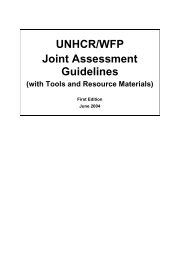Food Security Atlas of Rural Bihar - WFP Remote Access Secure ...
Food Security Atlas of Rural Bihar - WFP Remote Access Secure ...
Food Security Atlas of Rural Bihar - WFP Remote Access Secure ...
Create successful ePaper yourself
Turn your PDF publications into a flip-book with our unique Google optimized e-Paper software.
to decide on the districts in which to concentrate food security interventions, then such a ranking<br />
would be sufficient. But this would say nothing about the types <strong>of</strong> interventions that should be<br />
undertaken in order to improve food security, which is one <strong>of</strong> the key objectives <strong>of</strong> the study.<br />
However, food security indicators can draw attention to the factors and specific areas that distinguish<br />
the food secure from the food insecure districts. Of course, such association between indicators in<br />
an index cannot tell us what the causal relation between them and food security is. For instance, if<br />
we find that the adult female literacy is consistently higher in food secure districts and consistently<br />
lower in food insecure districts that only shows a correlation between adult female literacy and food<br />
security. A deeper analysis is required to explain why such a relationship exists. Whether it is due to<br />
an enhanced women’s agency contributing to a better utilisation <strong>of</strong> household income, or through<br />
literate women having a better knowledge <strong>of</strong> improved nutritional practices, or some other relation,<br />
it is for analysis to bring out these relations. But the indicators can draw attention to the issues for<br />
which significant differences exist. It would even be possible to rank these variables, a rank that would<br />
point to the extent to which these variables are different between districts. Such an analysis could<br />
also point to variations between food insecure districts – the same variables may not contribute the<br />
most to the low index in all districts, or some <strong>of</strong> them may even move in opposite directions.<br />
<strong>Food</strong> security is the ability <strong>of</strong> a household to command food (its food entitlements), generally acquired<br />
through the net result <strong>of</strong> its livelihood activities (plus any other non-livelihood-based entitlements),<br />
that is crucial in determining food security <strong>of</strong> the household. These livelihood activities, from the point<br />
<strong>of</strong> view <strong>of</strong> food security, are valued not only for the food they might directly produce, if at all they<br />
produce food, but also from the point <strong>of</strong> the command over food that they give to the household. It is<br />
at this level <strong>of</strong> effective demand for food (both consumed out <strong>of</strong> self-production and purchased) that<br />
market failures take place, requiring public intervention <strong>of</strong> different kinds. <strong>Food</strong> production, or<br />
agricultural production contributes as main part <strong>of</strong> rural livelihood activities that provide command<br />
over food.<br />
Within a household, it is known that there are gender differences in entitlements. Consequently, it is<br />
necessary to deal with not just factors influencing household entitlements, but also those influencing<br />
individual entitlements within the household. Factors <strong>of</strong> gender differentiation and discrimination come<br />
into the picture in influencing individual entitlements <strong>of</strong> women and men, girls and boys. Further, there<br />
could be a substantial imbalance between the use <strong>of</strong> energy and its replacement through food. Given<br />
that women generally work longer hours than men and that women also get less nutrition than men,<br />
this imbalance could itself be a factor in nutritional shortfalls for women.<br />
Entitlements are not only based on an individual’s or household’s own economic attainments. There<br />
are also government – or community-based – entitlements. Government-organised entitlements have<br />
been gaining in importance, while community-based entitlements have been in decline, even among<br />
adivasis. The operation <strong>of</strong> various schemes, such as the Mid-Day Meal Scheme in schools, do have<br />
30 FOOD SECURITY ATLAS OF RURAL BIHAR


